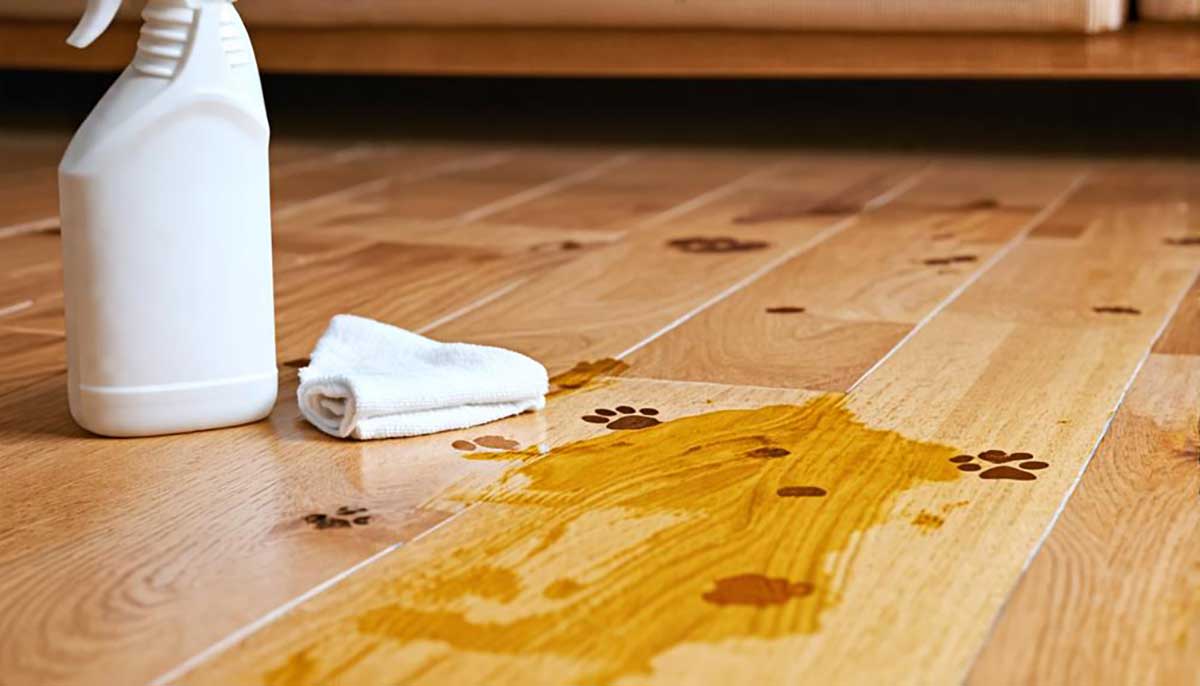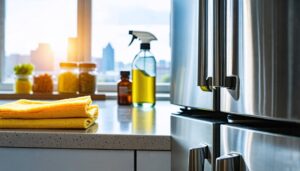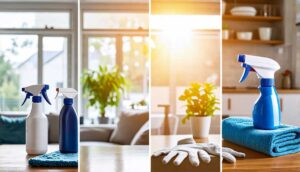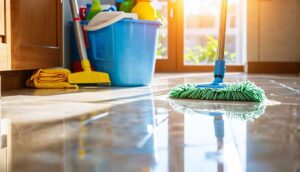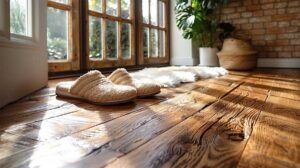To remove dog urine stains and odors from hardwood floors, act quickly by blotting excess urine with absorbent materials. Apply a cleaning solution of water, white vinegar, and mild dish soap to neutralize odors and lift stains. For stubborn spots, use enzymatic cleaners specifically designed for pet stains. Rinse the area with warm water and dry thoroughly. Baking soda can be applied overnight to absorb lingering odors. Regular floor sealing and prompt cleanup routines help prevent future damage. For severe cases, consider steam cleaning or professional restoration. Understanding the depth of urine penetration and wood type is essential for effective treatment and long-term floor protection.
Understanding Pet Stains on Wood
Dog urine can cause various types of damage to hardwood floors, including discoloration, warping, and etching of the wood surface. The extent of damage depends on factors such as the wood species, finish type, and duration of urine exposure. Understanding the depth of urine penetration is vital, as it can seep through the protective finish and into the wood fibers, potentially requiring more intensive restoration methods beyond surface cleaning.
Types of Wood Damage
On hardwood floors, pet urine can cause various types of damage, each requiring specific understanding for effective treatment. The acidity of dog urine can penetrate the protective finish of hardwood floors, leading to long-term degradation if not promptly addressed. Sealed hardwood floors offer better resistance to urine stains compared to unsealed wood, but both remain susceptible to damage without immediate intervention.
The types of damage caused by dog urine on hardwood floors include:
- Surface discoloration and dark spots
- Warping or cupping of wood planks
- Degradation of wood fibers and structural integrity
- Penetration of odor-causing bacteria into wood pores
The severity of urine damage depends on factors such as wood type, finish quality, and duration of exposure. To prevent urine from damaging your hardwood, quick action is essential. Blot up excess liquid immediately and apply a cleaning solution to neutralize acids and eliminate odors. Different wood species may react distinctly to urine stains, necessitating tailored cleaning approaches. Understanding the specific wood finish and type in your home is vital for implementing effective cleaning strategies and preventing long-term damage from dog urine accidents.
Depth of Urine Penetration
Understanding the depth of urine penetration is vital when addressing pet stains on hardwood floors. The extent of absorption depends on several factors, including the duration the urine remains untreated and the type of finish on the wood surface. Sealed hardwood floors offer superior protection against urine infiltration compared to unsealed wood, which allows for deeper penetration.
When attempting to remove dog urine stains from hardwood floors, it is important to assess the depth of penetration accurately. Superficial stains may be addressed with topical cleaning methods, while deeper penetration might require more extensive treatment or professional intervention. The moisture from urine can cause significant damage to your hardwood, potentially leading to warping or discoloration if not properly cleaned and dried promptly.
To effectively neutralize the urine and prevent long-term damage, it is imperative to act swiftly. The cleaning process should involve blotting up excess urine, applying a specialized cleaning solution, and ensuring thorough drying. In cases of severe penetration, where the urine has reached the subfloor, more aggressive measures may be necessary to completely eliminate the stain and odor.
Immediate Actions for Fresh Stains
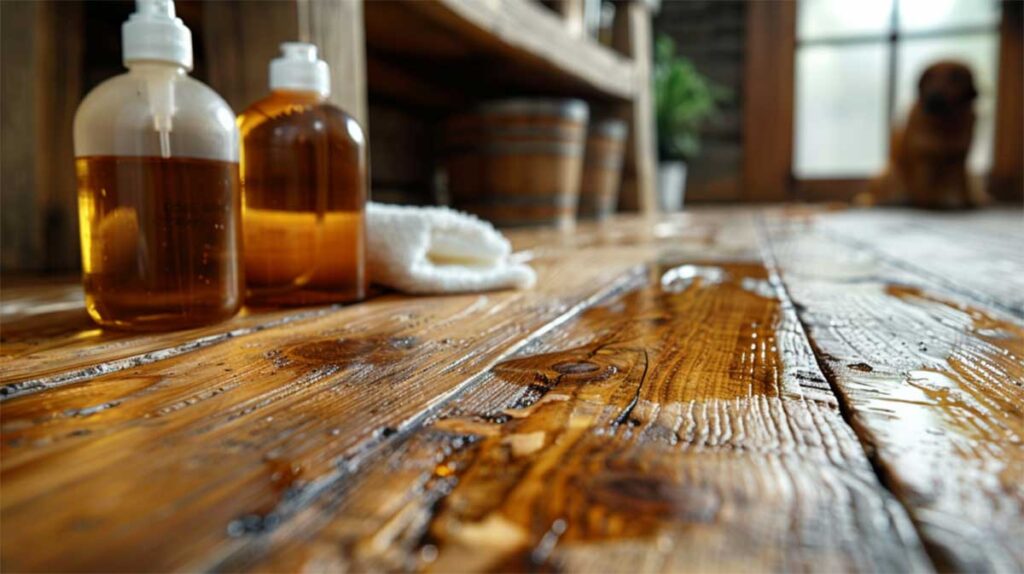
When addressing fresh dog urine stains on hardwood floors, immediate action is vital. Begin by blotting excess urine with absorbent materials to minimize liquid penetration into the wood. Rapidly neutralizing the odor and preventing further absorption are essential steps in mitigating long-term damage to the flooring.
Blot Excess Urine
Swiftly blotting excess urine is vital when addressing fresh dog urine stains on hardwood floors. This immediate action significantly reduces the risk of long-term damage and odor retention in the wood. Begin by using multiple layers of paper towels to absorb as much liquid as possible without rubbing, which could spread the stain and cause further damage to the wood finish.
To effectively blot excess urine:
- Place a thick stack of paper towels directly over the affected area
- Apply firm, steady pressure to the paper towels using your hand or foot
- Lift the saturated paper towels and replace with fresh ones
- Repeat the process until no more moisture is being absorbed
It is important to avoid scrubbing the area, as this can force the urine deeper into the wood fibers and exacerbate the stain. Instead, focus on gentle dabbing motions to maximize absorption. Change the paper towels frequently to guarantee continuous moisture removal. This initial blotting process should be performed within the first few minutes of discovering the stain for best results, minimizing the potential for lasting damage to your hardwood floors.
Neutralize Odor Quickly
After blotting excess urine, the next step is to neutralize the odor quickly. To effectively remove urine and eliminate urine odor from hardwood floors, prepare a cleaning solution consisting of one cup of water, one-third cup of white vinegar, and one-quarter cup of mild dish soap. This mixture is specifically formulated to target fresh stains and neutralize the urine smell from hardwood floors.
Apply the cleaning solution directly to the affected area, guaranteeing thorough coverage. Allow the solution to sit for approximately 15 minutes, allowing it to penetrate the stain and effectively neutralize odor-causing compounds. After the designated time, rinse the area thoroughly with warm water to remove any residual cleaning solution.
For persistent odors, employ an additional step by sprinkling baking soda over the cleaned area. Let it sit overnight to absorb and neutralize any lingering smells. Vacuum the baking soda the following day. Before applying any cleaning solution, conduct a spot test in an inconspicuous area to guarantee compatibility with the wood finish, preventing potential damage to the flooring.
Prevent Liquid Absorption
The battle against dog urine stains on hardwood floors begins with swift absorption. Immediate action is vital to prevent the urine from penetrating deeper into the wood, which can lead to long-term damage and persistent odors. When addressing a fresh urine stain, employ the following steps:
- Quickly locate multiple clean cloths or paper towels
- Position the absorbent material directly over the urine stain
- Apply gentle, consistent pressure to the cloth or towel
- Replace saturated materials with fresh ones as needed
Blot the affected area methodically, focusing on absorbing as much liquid as possible without rubbing, which could exacerbate the problem by pushing the urine further into the wood grain. Continue this process until no more moisture transfers to the absorbent material. If time permits before preparing a cleaning solution, place a weighted object over a final dry cloth to improve absorption.
Proper disposal of contaminated materials and thorough hand washing are essential to maintain hygiene throughout this process. By acting swiftly and effectively to prevent liquid absorption, you significantly reduce the risk of permanent staining and set the stage for more thorough cleaning and odor neutralization in subsequent steps.
Cleaning Solutions and Techniques
Effective cleaning solutions for dog urine stains on hardwood floors range from homemade mixtures to specialized commercial products. Homemade solutions typically combine water, vinegar, and baking soda, while enzymatic cleaners offer targeted formulations designed to break down pet urine components. For persistent stains, steam cleaning techniques can be employed, utilizing heat and moisture to penetrate wood fibers and lift embedded odors and discoloration.
Homemade Cleaning Mixtures
Creating effective homemade cleaning mixtures can significantly boost the process of removing dog urine stains from hardwood floors. A recommended solution combines 1 cup of water, 1/3 cup of white vinegar, 1/4 cup of baking soda, and 1/4 cup of mild dish soap. This mixture effectively targets stains and odors, breaking down urine compounds and neutralizing unpleasant smells.
For more stubborn stains, hydrogen peroxide can be used alone or combined with baking soda and dish soap. This potent solution penetrates deep into the wood fibers, oxidizing and eliminating persistent odors. Alternatively, mixing 1 cup of white vinegar with warm water and adding grapefruit oil amplifies deodorizing properties while acting as a natural disinfectant.
When applying these homemade cleaning mixtures to clean hardwood floors:
- Blot excess urine with a clean cloth
- Apply the chosen solution to the affected area
- Allow the mixture to sit for 15 minutes
- Rinse thoroughly with warm water
For severe cases, apply a thick layer of baking soda overnight to absorb moisture and odors before vacuuming. Always test any homemade cleaning solution on an inconspicuous area first to verify compatibility with the floor’s finish and prevent discoloration.
Commercial Enzymatic Cleaners
Commercial enzymatic cleaners offer a powerful solution for removing dog urine stains and odors from hardwood floors. These specialized products are formulated to target and break down the organic compounds present in pet urine, effectively neutralizing both visible stains and lingering odors.
To clean your floors using a commercial enzymatic cleaner, begin by thoroughly blotting the affected area with a clean cloth to remove as much moisture as possible. This preparatory step improves the cleaner’s effectiveness by allowing deeper penetration. Apply the pet stain remover generously to the urine-affected area, guaranteeing complete coverage. Allow the enzymatic solution to sit for the manufacturer-recommended duration, typically ranging from 15 minutes to several hours. This extended contact time enables the natural enzymes to fully digest the urine components.
For stubborn stains or persistent odors, multiple applications may be necessary. The enzymes continue to work as long as the area remains damp, so avoid prematurely drying the treated spot. Once the recommended time has elapsed, blot the area again to remove excess moisture and allow it to air dry completely. This process assures ideal results in neutralizing dog urine stains and odors on hardwood floors.
Steam Cleaning Techniques
In the case of removing dog urine stains from hardwood floors, steam cleaning is not a recommended approach. The high heat and excessive moisture generated by steam cleaners can potentially damage hardwood floors, causing warping, swelling, or separation of the wood planks. Instead, homeowners should opt for gentler cleaning methods that are specifically designed for hardwood surfaces.
To effectively remove pet urine stains and odors from hardwood floors, consider the following alternatives to steam cleaning:
- Blot the affected area with clean, absorbent cloths
- Apply a mild, hardwood-safe cleaning solution
- Gently scrub the stain using a soft-bristled brush
- Rinse with a damp cloth and dry thoroughly
When selecting a cleaning solution for hardwood floors, choose products that are pH-neutral and specially formulated for wood surfaces. These solutions are designed to clean effectively without compromising the floor’s finish or integrity. Always test the cleaning solution on an inconspicuous area before applying it to the stained region to verify compatibility with your specific hardwood floor.
Regular maintenance using appropriate cleaning techniques can help prevent the buildup of pet urine odors and stains, preserving the beauty and longevity of your hardwood floors.
Odor Removal Strategies
Effective odor removal from dog urine on hardwood floors requires a multifaceted approach. Natural deodorizing solutions, such as baking soda and vinegar mixtures, can neutralize acidic urine components and absorb lingering smells. Enzymatic cleaners offer a targeted solution by breaking down specific urine molecules, while air purification methods can complement these treatments by eliminating airborne odor particles.
Natural Deodorizing Solutions
Several natural deodorizing solutions offer effective strategies for removing dog urine odors from hardwood floors. White vinegar, known for its antibacterial properties and ability to break down uric acid in urine, can be mixed with water to create a potent cleaning solution. Baking soda, a powerful natural deodorizer, absorbs moisture and odors when sprinkled over affected areas and left overnight. Hydrogen peroxide not only lifts stains but also neutralizes odors, making it suitable for treating dog urine on hardwood surfaces.
To effectively utilize these natural deodorizing solutions, follow these steps:
- Blot excess urine with a clean cloth
- Apply a vinegar-water solution to the affected area
- Sprinkle baking soda over the cleaned spot and leave overnight
- Vacuum the dried baking soda and apply hydrogen peroxide if needed
For improved effectiveness, consider incorporating essential oils like grapefruit oil into your cleaning mixture. These natural oils provide a pleasant scent while contributing to odor elimination when combined with vinegar. Regular application of these solutions helps maintain a fresh-smelling environment and prevents the recurrence of odors associated with pet accidents, ensuring your hardwood floors remain clean and odor-free.
Enzymatic Cleaners
Enzymatic cleaners represent a powerful solution for removing dog urine odors from hardwood floors. These specialized cleaning products utilize natural enzymes to break down the organic compounds present in urine, effectively neutralizing odors rather than merely masking them. Unlike traditional cleaning methods, enzymatic cleaners target the source of the problem, making them particularly effective against both dog and cat urine stains and odors.
To achieve the best results when using enzymatic cleaners to remove dog urine stains from hardwood floors, it is essential to follow the manufacturer’s instructions carefully. Allow the product to sit on the affected area for the recommended duration, ensuring thorough penetration and breakdown of the urine components. For stubborn or set-in stains, multiple applications may be necessary to completely eliminate odors and stains. Before applying the cleaner to the entire affected area, it is advisable to test it on an inconspicuous spot to prevent potential discoloration or damage to the floor’s finish. By incorporating enzymatic cleaners into your cleaning routine, you can effectively maintain clean, odor-free hardwood floors while addressing pet-related stains and odors at their source.
Air Purification Methods
Air purification methods offer a comprehensive approach to combating lingering dog urine odors on hardwood floors. HEPA filters effectively trap airborne particles and allergens, significantly reducing pet odors. Activated charcoal air purifiers excel at neutralizing volatile organic compounds and odor-causing substances released from urine stains. These purifiers work continuously to cycle air and remove persistent pet odors, promoting a healthier indoor environment.
To improve air quality and mask unpleasant smells, consider incorporating essential oils known for their deodorizing properties, such as grapefruit or lemon, in diffusers. Proper ventilation in areas prone to pet accidents is vital for dissipating odors and enhancing overall air quality.
Implement these air purification methods for best results:
- Install HEPA filter air purifiers in rooms with hardwood floors
- Place activated charcoal pouches strategically near affected areas
- Use essential oil diffusers with citrus scents to neutralize odors
- Guarantee adequate ventilation by opening windows or using fans regularly
Preventive Measures and Maintenance
Implementing preventive measures and consistent maintenance can significantly reduce the occurrence of dog urine stains on hardwood floors. Regular floor sealing creates a protective barrier against stains and simplifies the cleaning process after accidents. Effective pet training, coupled with a quick clean-up routine, forms a comprehensive strategy to minimize damage and preserve the integrity of hardwood flooring.
Regular Floor Sealing
Regular floor sealing stands out as an important preventive measure in protecting hardwood floors against dog urine stains and damage. By applying a sealant every 3 to 5 years, homeowners create a protective barrier that significantly reduces the porosity of the wood, thereby minimizing urine penetration and odor retention. This process is particularly vital for high-traffic areas, which are more susceptible to wear and tear from pets.
When maintaining hardwood floors through regular floor sealing, consider the following key points:
- Choose pet-friendly sealants to guarantee the safety of household animals
- Prioritize sealing in areas where pets frequently roam or accidents occur
- Apply sealant evenly across the floor surface for uniform protection
- Allow adequate drying time between coats for best durability
The sealing process not only improves the floor’s resistance to stains and damage but also preserves its aesthetic appeal and longevity. By implementing this preventive measure, homeowners can protect their hardwood floors more effectively against the potential long-term effects of pet accidents. Regular floor sealing, combined with prompt cleaning of urine stains, forms a comprehensive strategy for maintaining the integrity and appearance of hardwood flooring in homes with pets.
Training Pets Effectively
While regular floor sealing provides a physical barrier against urine stains, effective pet training serves as a behavioral safeguard to prevent accidents on hardwood floors. Implementing consistent potty training routines is essential for reinforcing good habits and reducing indoor elimination. This includes establishing regular outdoor breaks and a designated bathroom area, which encourages pets to associate specific locations with elimination.
Positive reinforcement techniques play an important role in successful training. Offering treats and praise when pets eliminate outdoors strengthens the connection between desired behavior and rewards. Simultaneously, closely monitoring pets for signs of needing to go out, such as sniffing or circling, allows owners to preemptively prevent accidents.
Regular vet check-ups are necessary for identifying underlying health issues that may contribute to frequent accidents. These examinations enable timely interventions and necessary adjustments to training protocols. By addressing potential medical concerns, owners can tailor their approach to each pet’s specific needs, enhancing the effectiveness of their training efforts.
Combining these strategies creates a comprehensive approach to pet training, significantly reducing the likelihood of urine stains on hardwood floors and promoting a cleaner, more hygienic living environment for both pets and their owners.
Quick Clean-up Routine
A proactive approach to preventing dog urine stains on hardwood floors begins with establishing a quick clean-up routine. This routine should encompass immediate action upon discovering an accident, as well as regular maintenance to protect your floors from potential damage. Implementing a consistent clean-up protocol can significantly reduce the likelihood of long-term staining and odor issues.
To effectively eliminate the urine and protect your floors, follow these steps:
- Blot the area with absorbent paper towels or cloths
- Apply a cleaning solution of water, vinegar, and baking soda
- Rinse thoroughly with warm water
- Dry the area completely using fans or open windows
Incorporating preventive measures into your routine can further safeguard your hardwood floors. Regularly sealing the floors creates a protective barrier against pet stains, facilitating easier clean-up. Strategically placing area rugs in high-traffic zones or areas prone to accidents can provide an additional layer of protection. Establishing a schedule for frequent pet outings and monitoring can minimize indoor accidents. By consistently maintaining your floors and addressing any pet health issues promptly, you can identify potential problems early and prevent severe damage to your hardwood surfaces.
Frequently Asked Questions
How to Get Old Dog Urine Smell Out of Hardwood Floors?
Like a persistent ghost haunting an old house, the lingering odor of canine urine can stubbornly cling to hardwood floors. To exorcise this olfactory specter, employ a specialized cleaning solution comprising water, white vinegar, baking soda, and mild dish soap. Apply generously to affected areas, allowing 15 minutes for penetration. Subsequently, utilize hydrogen peroxide treatment with a cloth cover for extended periods. Finalize by applying baking soda overnight, then vacuum. For refractory cases, consult professional floor cleaning experts.
Can You Get Old Pee Stain Out of Hardwood Floor?
Removing old urine stains from hardwood floors is possible but challenging. For best results, utilize a specialized enzymatic cleaner designed to break down organic compounds. Alternatively, create a solution of hydrogen peroxide, baking soda, and dish soap. Apply the chosen mixture to the affected area, allowing adequate penetration time. Multiple applications may be necessary for stubborn stains. If DIY methods prove ineffective, consider consulting a professional hardwood floor cleaning service for advanced treatment options and expertise.
Does Dog Pee Ruin Hardwood Floors?
Just as a single drop of acid can etch glass, dog urine can indeed ruin hardwood floors. The acidic nature of canine urine penetrates wood fibers, causing discoloration, warping, and potential structural damage. Urine’s corrosive properties can break down the floor’s protective sealant, exposing the wood to further deterioration. Prolonged exposure may lead to deep-set stains, persistent odors, and compromised integrity of the flooring. In severe cases, the damage can necessitate costly replacements, with new hardwood installations potentially exceeding $400.
What Is the Best Cleaner to Remove Urine Smell From Hardwood Floors?
The most effective cleaner for removing urine odors from hardwood floors is a solution comprising one cup of water, one-third cup of white vinegar, and one-quarter cup of mild dish soap. This mixture neutralizes odors and addresses stains efficiently. Alternative options include hydrogen peroxide for deeper stains, baking soda for odor absorption, and enzymatic cleaners specifically designed to break down urine components. It is essential to perform a spot test before applying any solution to prevent potential damage to the floor’s finish.

